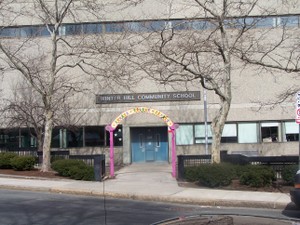
The Winter Hill Community School may soon be an Innovation School.
Somerville Public Schools stand on the brink of change
By Andrew Firestone
Innovation is a loaded word, especially in education. An Innovation school is a school within the district that allows for more flexibility in hours and teaching methods, meant to act as an incubator for cutting-edge teaching methods. And soon, in all likelihood, the Winter Hill Community School will be one.
Somerville’s public school system has been the cause of much debate of late, especially with the proposal by a group of parents to build a Charter School in East Somerville. Complaints have centered on chronically low MCAS scores, which rank in the bottom 10 percent of the state.
Perhaps staged by catalyst, or perhaps part of a growing trend in American education, the Somerville School Committee has delivered an initial prospectus on the proposed Winter Hill Community School. The State Department of Elementary Secondary Education will vote on a $15,000 grant for the planning of the change in classification for the Winter Hill Community Innovation School, which will most likely be approved.
Already at least three other schools in the district have voiced desire towards the same. The change would most likely thrust responsibility for the school curriculum and hours upon the teachers and staff.
And they are all just fine with that. And they have the Mayor’s support.
“At this early stage, my suggestion is that we give [control] up, not control it,” said Chairman Paul Bockelman.
Ward 3 member Adam Sweeting urged for “a real focus on achievement gaps. I think that to me, that’s a fundamental, almost moral, issue.”
“We’re taking steps, and we need to move faster. I think that if we can create an environment that’s nimble, that allows us to do that and can close those gaps, it has the benefit of taking a little heat off the district, but that’s not the only reason to do it. The reason to do it is to close achievement gaps. I’m looking at schools that are really addressing really vulnerable populations.”
The Winter Hill Community School currently houses 27 percent special education students with 21 percent limited English proficient students. The school body is comprised of 85.5 percent who are low income. They would thus qualify as a vulnerable population.
An excerpt from the prospectus of the school provided by the Somerville SPS reads: “with the increased autonomy that an Innovation School affords, Winter Hill hopes to strengthen the school’s current approach to individualized instructional methods with new and innovative practices, build on the strengths of an educational partnership model that includes all stakeholders, and adopts increased experiential learning opportunities that support its vision of academic excellence for all students.”
The class size at the proposed innovation school would be 18.4 with a student-to-teacher ratio of 10.6 to 1.
“By leveraging the autonomy and focus afforded by the Innovation School structure, The Winter Hill Community Innovation School will take this process to a higher level. Immediate changes will be realized in an increased focus on individualized instructional approach, greater autonomy both in the development of educational programs in the structure of the school learning day, and a stronger commitment to fostering community engagement and partnerships designed to provide students and families from varying backgrounds with a truly enriching learning experience,” the prospectus reads.
“A focus on teaching and learning approaches that solicit and encourage student input, provide opportunities for student leadership engagement, and strengthen student-teacher communication and collaboration will be the core features of the school’s educational approach.”
In short, the responsibility would be taken away from senior level staff, and brought down to the faculty and teachers who work at the school. They would receive more of the weight for the performance of their class on MCAS tests.
The Innovation School program was made possible due to the state passing “An Act Relative to the Achievement Gap” which allowed for increased autonomy within districts in schedule, budget, curriculum, staffing, professional development and school district policies. But what this really means is quite radical.
With these new guidelines, there would be less of an emphasis on “cookie cutter” education, and more of ability from the classroom level to try-out different teaching methods. This culture places added weight upon the teacher, as well as the student.
“What I really learned through this process [of researching innovation schools] is how the innovation school concept empowered the teacher and staff at that school,” said Ward 5 member Mark Niedergang. “That is something that I hadn’t understood. To hear it in practice, to hear the excitement and the energy that they generated by this structural change in the faculty and the leadership in the faculty, and the ownership that they took.”
Mayor Joseph Curtatone was overwhelmingly supportive of it. He urged the school committee to “get out of our zone a little bit and shoot beyond incremental change.”
“I’m sick of getting drowned in the same bureaucracy that gets part of this conversation for years. It’s part of the frustration that I hear from the community.”
“People don’t want incremental change. They want transformative steps and thinking by this committee and the city and I’m going to support it. I want to encourage ‘let it rip.’ We can’t afford to wait,” he said.
Superintendent Anthony Pierantozzi had also submitted an application for a large grant from the Bill and Melinda Gates Foundation, this one to start another school-within-a-school geared towards scientific study at Somerville High.
Pierantozzi was adamant that this was an exciting time for the Somerville Public Schools, and saw this period as one of transformation in terms of shaping the future of the SPS.
















Reader Comments